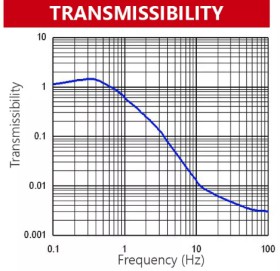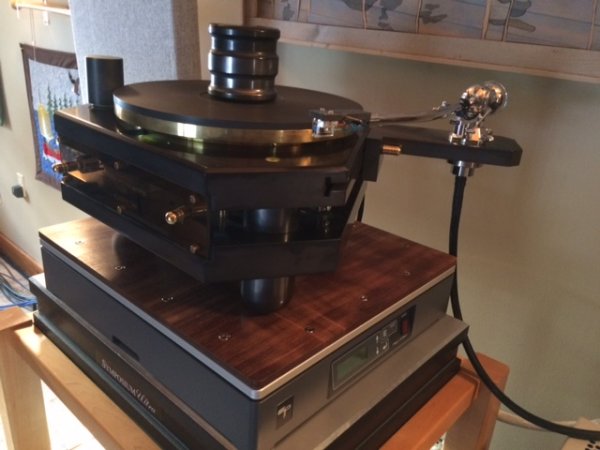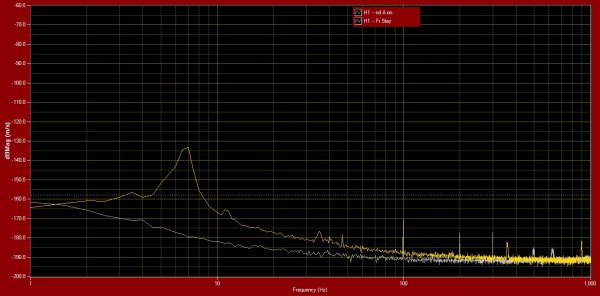I didn’t Peter. But I presumed the concept of active electronics an inch away from my sensitive tube gear and assocd psus wasn’t a good idea in principle. I have to seperate my pre and pre psu by at least 6”, I wasn’t about to take a punt on active electronics right under my pre etc.
Taiko Tana-LPS-Setchi---listening
- Thread starter Mike Lavigne
- Start date
You are using an out of date browser. It may not display this or other websites correctly.
You should upgrade or use an alternative browser.
You should upgrade or use an alternative browser.
Tana Setchi combo on pretty bendy suspended wood floor
Today, I had my third customer data point.
Lampi GG > Asthetix pre > Lampi mono blocs > Evo Acoustics MM2 all on a suspended wood floor.
The Tana with active enabled could not handle people walking across the room !
However, when we sat down, the active isolation was able to get the top plate under control and stable in less than 2 seconds
When the music started to play there was a very definite improvement in the tightness of the bass. Clarity increased, and tonal body was very nicely denser and richer
Very challenging floor structure for active anti-vibration, but the Tana + LPS + Setchi combo was still able to delivery a very enjoyable SQ uplift with no audible negatives.
After this observational data point, we will be happy to do demos in sound rooms with suspended floors !
Today, I had my third customer data point.
Lampi GG > Asthetix pre > Lampi mono blocs > Evo Acoustics MM2 all on a suspended wood floor.
The Tana with active enabled could not handle people walking across the room !
However, when we sat down, the active isolation was able to get the top plate under control and stable in less than 2 seconds
When the music started to play there was a very definite improvement in the tightness of the bass. Clarity increased, and tonal body was very nicely denser and richer
Very challenging floor structure for active anti-vibration, but the Tana + LPS + Setchi combo was still able to delivery a very enjoyable SQ uplift with no audible negatives.
After this observational data point, we will be happy to do demos in sound rooms with suspended floors !
Well, I can move about with my passive pneumatic Stacore supporting tt and highly sensitive air bearing linear tracking arm with absolutely zero mistracking issues.
And 40 hrs into a brutal burn in period (linked to other aspects of my analog dial in), I’m also getting stellar results.
Ok, what we can conclude from Tana working as well on a suspended floor, and my passive platform experience being wholly positive, is that my inferior experience of active Kuraka (direct equivalent of Herzan) is nothing to do with active not being suited to non solid floors, and everything to do with the Stacore being absolutely top drawer in terms of performance.
And 40 hrs into a brutal burn in period (linked to other aspects of my analog dial in), I’m also getting stellar results.
Ok, what we can conclude from Tana working as well on a suspended floor, and my passive platform experience being wholly positive, is that my inferior experience of active Kuraka (direct equivalent of Herzan) is nothing to do with active not being suited to non solid floors, and everything to do with the Stacore being absolutely top drawer in terms of performance.
Audio Silente TT on TS 150 on suspended wood floor
We have a report of an Italian Audio Silente turntable sitting on a Taiko Tana TS-150 sized platform powered by the Tana LPS. The dynamics of the Silente as well as bass clarity take another step up, the owner is very impressed
When the owner walks across the floor, the motion is outside the range of correction of the Tana. However once he sits down, and there is music playing, he can see from the screen that the active anti-vibration control is correcting the music generated vibrations, and the sonics are at a new level
We have a report of an Italian Audio Silente turntable sitting on a Taiko Tana TS-150 sized platform powered by the Tana LPS. The dynamics of the Silente as well as bass clarity take another step up, the owner is very impressed
When the owner walks across the floor, the motion is outside the range of correction of the Tana. However once he sits down, and there is music playing, he can see from the screen that the active anti-vibration control is correcting the music generated vibrations, and the sonics are at a new level
Ed,
not surprised on this outcome with the Taiko Tana and this turntable. yesterday I listened to my NVS tt with the Taiko Tana for 7 hours, pulled out numerous Lps I had not listened to in a while, and they went to a new level of musicality with the Taiko Tana now under it, as well as another Taiko Tana underneath my preamp.
Mike
not surprised on this outcome with the Taiko Tana and this turntable. yesterday I listened to my NVS tt with the Taiko Tana for 7 hours, pulled out numerous Lps I had not listened to in a while, and they went to a new level of musicality with the Taiko Tana now under it, as well as another Taiko Tana underneath my preamp.
Mike
Okay, Mike, you twisted my arm. 
I took your advice and I ordered a full Taiko Tana set-up with Panzerholz/aluminum top plate and the LPS with Panzerholz “bathtub” for the Io amplification unit.
At the moment the Setchi is, for me, a step too far.
I took your advice and I ordered a full Taiko Tana set-up with Panzerholz/aluminum top plate and the LPS with Panzerholz “bathtub” for the Io amplification unit.
At the moment the Setchi is, for me, a step too far.
Okay, Mike, you twisted my arm.
I took your advice and I ordered a full Taiko Tana set-up with Panzerholz/Aluminum top plate and the LPS with Panzerholz “bathtub” for the Io amplification unit.
Well done. Great isolation should be an amazing thing on a system like yours.
Okay, Mike, you twisted my arm.
I took your advice and I ordered a full Taiko Tana set-up with Panzerholz/aluminum top plate and the LPS with Panzerholz “bathtub” for the Io amplification unit.
At the moment the Setchi is, for me, a step too far.
Ron, congrats on this move. obviously you know what I think already. the Taiko Tana treatment will optimize whatever is put on it. it has in my own system for sure. and I agree with Lloyd about what it can do to push an 'uber' system like yours that much further.
Thank you, Lloyd! It is mercifully uncontroversial that a sensitive active-isolation system makes sense underneath a box festooned with tubes which amplifies the smallest signals in our hobby.
Vibration spectrum analysis of Good Passive vs Good Active
We have acquired a Herzan WaveCatcher set to gether with Table Stables highly sensitive 3 axis vibrometer. Our initial tests are just measurements of the background noise of the listening room and building with no music playing
The first graph is a comparison of the spectrum analysis of Horizontal room vibrations with passive and active platforms
yellow line - a good passive system with 3 ceramic ball footers
blue line - Herzan / Tana TS 150
The second graph is a comparison of Vertical room vibrations measured on passive and active platforms
yellow line - a good passive system with 3 ceramic ball footers
blue line - Herzan / Tana TS 150
The magnitude of Horizontal low frequency vibrations with the ceramic ball footers was something we did not expect, but certainly points to reasons why active anti vibration systems done well can make a very audible improvement. The reduction of the peak at 7 Hz is over 45 dB !!
The reduction of vertical vibrations is also very significant, a reduction of 30 dB at 7Hz
The FFT's are averages done over 10 samples, each sample running for 10 seconds of data collection
We have acquired a Herzan WaveCatcher set to gether with Table Stables highly sensitive 3 axis vibrometer. Our initial tests are just measurements of the background noise of the listening room and building with no music playing
The first graph is a comparison of the spectrum analysis of Horizontal room vibrations with passive and active platforms
yellow line - a good passive system with 3 ceramic ball footers
blue line - Herzan / Tana TS 150
The second graph is a comparison of Vertical room vibrations measured on passive and active platforms
yellow line - a good passive system with 3 ceramic ball footers
blue line - Herzan / Tana TS 150
The magnitude of Horizontal low frequency vibrations with the ceramic ball footers was something we did not expect, but certainly points to reasons why active anti vibration systems done well can make a very audible improvement. The reduction of the peak at 7 Hz is over 45 dB !!
The reduction of vertical vibrations is also very significant, a reduction of 30 dB at 7Hz
The FFT's are averages done over 10 samples, each sample running for 10 seconds of data collection
We have acquired a Herzan WaveCatcher set to gether with Table Stables highly sensitive 3 axis vibrometer. Our initial tests are just measurements of the background noise of the listening room and building with no music playing
The first graph is a comparison of the spectrum analysis of Horizontal room vibrations with passive and active platforms
yellow line - a good passive system with 3 ceramic ball footers
blue line - Herzan / Tana TS 150
The second graph is a comparison of Vertical room vibrations measured on passive and active platforms
yellow line - a good passive system with 3 ceramic ball footers
blue line - Herzan / Tana TS 150
The magnitude of Horizontal low frequency vibrations with the ceramic ball footers was something we did not expect, but certainly points to reasons why active anti vibration systems done well can make a very audible improvement. The reduction of the peak at 7 Hz is over 45 dB !!
The reduction of vertical vibrations is also very significant, a reduction of 30 dB at 7Hz
The FFT's are averages done over 10 samples, each sample running for 10 seconds of data collection
It should be great if you could measure vibration with the active platform switched on and switched off and without active platform. Ball bearings with cups are not a proper reference IMHO.
wow!!
nice to see what I'm hearing in my room with my 2 Taiko Tana systems.
thank you Ed.
+1
Nice to see what I will be hearing someday in my room.
Nice measurements, but I think it makes sense to put them in the right perspective. With the displacement excitation of passive systems (like with the ball bearings measured here), the higher the resonant peak the better (!) Very counterintuitive but that's physics. This is what gives a good isolation starting from 1.4 x the resonant frequency. However 7hz is ample a lot, I would not use such bearings, 1.7Hz would be a good bearing.
Cheers,
Cheers,
It should be great if you could measure vibration with the active platform switched on and switched off and without active platform. Ball bearings with cups are not a proper reference IMHO.
The ball bearing footers we have are much more sophisticated than ball in cup, have very good reviews in the last 6 months, and IMHO sound pretty good because of the job they do in the medium and high frequency ranges.
I need to get hold of some decent spikes for another comparison of passive, spiked to floor and active.
The difference between active on and off is huge, but as we know from rockitman's experience, medium and high frequency can damagingly dominate and overwhelm the benefits of good low frequency control
Somebody can hear a 7hz negative 135 db resonant peak while playing music? Congratulations.
These measurements are just background noise, no music playing
It's a bit of a challenge to take consistent measurements when music is playing, but its something we will be working on
We have acquired a Herzan WaveCatcher set to gether with Table Stables highly sensitive 3 axis vibrometer. Our initial tests are just measurements of the background noise of the listening room and building with no music playing
The first graph is a comparison of the spectrum analysis of Horizontal room vibrations with passive and active platforms
yellow line - a good passive system with 3 ceramic ball footers
blue line - Herzan / Tana TS 150
The second graph is a comparison of Vertical room vibrations measured on passive and active platforms
yellow line - a good passive system with 3 ceramic ball footers
blue line - Herzan / Tana TS 150
The magnitude of Horizontal low frequency vibrations with the ceramic ball footers was something we did not expect, but certainly points to reasons why active anti vibration systems done well can make a very audible improvement. The reduction of the peak at 7 Hz is over 45 dB !!
The reduction of vertical vibrations is also very significant, a reduction of 30 dB at 7Hz
The FFT's are averages done over 10 samples, each sample running for 10 seconds of data collection
Whoa gang. I love data as much as the next guy (maybe more!), but there are several questions and concerns that remain.
The “experiment” is missing two key controls. First, what would be the results we would see without any passive or active device? OK, I’m willing to not let that bother me since the point was to compare a passive vs active isolation system. However, it’s unfortunate that data is missing.
Second, what does the stock Herzan look like without the Taiko modified power supply?
Actually, if you look at the published Herzan data, you can notice some interesting findings.

According to Herzan, the results for all 6 degrees of freedom suggests a 99% reduction at 10Hz.
The measurements Eurodriver using the Herzan/ Tana TS indicate a 20dB and 30 dB reduction horizontally at 10 Hz and 100 Hz respectively. The data also show an approximately 30dB reduction at both 10Hz and 100HZ vertically.
In both cases, it seems these values are significantly less than that published by Herzan.
Although the ordinates of the scales are different, by my reckoning (Level in dB=20 x log (voltage ratio), Eurodriver’s data suggests there is roughly a 30% attenuation at 10 Hz vertically, where as Herzan’s data shows this to be closer to 99%.
Therefore, can someone help me in comparing Eurodriver’s data to that from Herzan? Please correct my understanding if my reasoning is incorrect. (If we were to use power gain instead of voltage gain, a -20dB change would indeed be a 2 log (or ~100%) attenuation but I don’t think power gain is the right metric here although perhaps I am wrong.
In either case, what I would really like to see is the Herzan TS transmission data with the stock vs Tana PS.
Last edited:
Similar threads
- Replies
- 2
- Views
- 868
- Replies
- 15
- Views
- 4K
- Replies
- 0
- Views
- 503
- Replies
- 7
- Views
- 1K
| Steve Williams Site Founder | Site Owner | Administrator | Ron Resnick Site Owner | Administrator | Julian (The Fixer) Website Build | Marketing Managersing |





